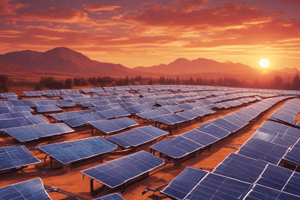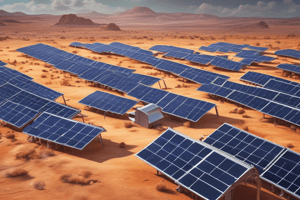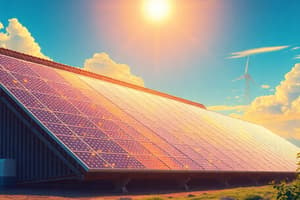Podcast
Questions and Answers
What is the function of a flat plate collector in solar energy systems?
What is the function of a flat plate collector in solar energy systems?
- To track the movement of the sun for maximum energy absorption
- To cool down the solar radiation for low-temperature applications
- To concentrate and focus solar radiation to increase radiation flux
- To convert solar energy into heat energy using the greenhouse effect (correct)
Which type of solar collector is most suitable for high-temperature applications?
Which type of solar collector is most suitable for high-temperature applications?
- Parabolic trough collector (correct)
- Compound parabolic collector
- Flat plate collector
- Evacuated tube collector
What is a distinguishing feature of compound parabolic collectors compared to flat plate collectors?
What is a distinguishing feature of compound parabolic collectors compared to flat plate collectors?
- They have the same area for intercepting solar radiation
- They use concave reflecting surfaces to focus solar radiation (correct)
- They are fixed and do not track the sun
- They convert solar energy using the greenhouse effect
Which type of solar collector includes a mechanism for suntracking?
Which type of solar collector includes a mechanism for suntracking?
In which type of solar collector does the radiation flux increase by focusing the sun’s beam to a smaller receiving area?
In which type of solar collector does the radiation flux increase by focusing the sun’s beam to a smaller receiving area?
Which solar collector design is commonly used for water and air heating in agricultural and domestic applications?
Which solar collector design is commonly used for water and air heating in agricultural and domestic applications?
What is the optimum tilt angle for flat plate solar collectors at a location with latitude 30°?
What is the optimum tilt angle for flat plate solar collectors at a location with latitude 30°?
Which type of solar collector can accept incoming radiation over a wide range of angles due to multiple internal reflections?
Which type of solar collector can accept incoming radiation over a wide range of angles due to multiple internal reflections?
Why are parallel serpentine designs preferred in flat plate collectors over serpentine designs?
Why are parallel serpentine designs preferred in flat plate collectors over serpentine designs?
What is the key feature of evacuated tube collectors compared to flat plate collectors?
What is the key feature of evacuated tube collectors compared to flat plate collectors?
Which type of solar collectors should be oriented towards the equator facing south in the Northern Hemisphere and north in the Southern Hemisphere?
Which type of solar collectors should be oriented towards the equator facing south in the Northern Hemisphere and north in the Southern Hemisphere?
What is the advantage of compound parabolic collectors over parabolic trough collectors?
What is the advantage of compound parabolic collectors over parabolic trough collectors?
Which type of solar collectors are cylindrical in shape and perform well even when sunlight is low?
Which type of solar collectors are cylindrical in shape and perform well even when sunlight is low?
Which type of solar collectors are considered to be the most efficient of all collector systems?
Which type of solar collectors are considered to be the most efficient of all collector systems?
Which type of solar collectors use mirrors that track the sun throughout the day?
Which type of solar collectors use mirrors that track the sun throughout the day?
Which type of solar collectors are particularly useful in areas with cold, cloudy wintry weathers?
Which type of solar collectors are particularly useful in areas with cold, cloudy wintry weathers?
Which type of solar collectors consist of a field of individually controlled mirrors reflecting sunlight onto a central receiver?
Which type of solar collectors consist of a field of individually controlled mirrors reflecting sunlight onto a central receiver?
Which type of solar collectors are known for always pointing to the sun?
Which type of solar collectors are known for always pointing to the sun?
Flashcards are hidden until you start studying





